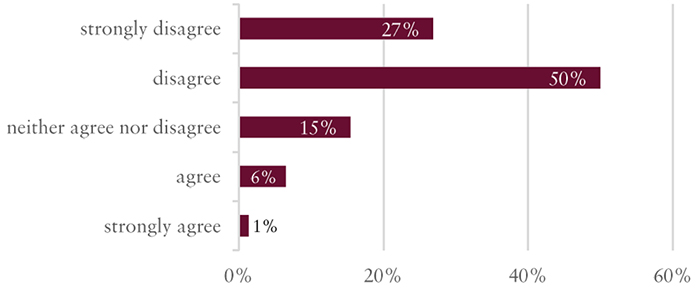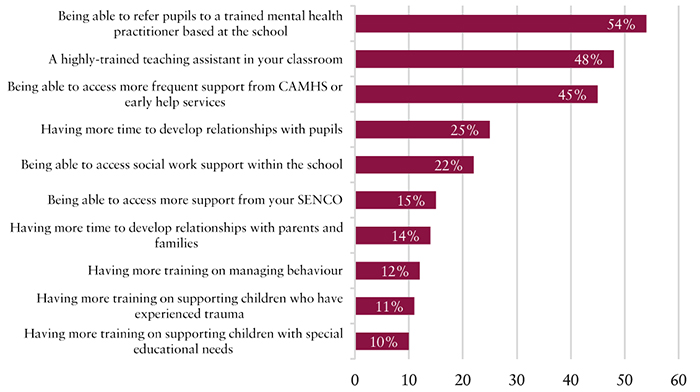Why do teachers exclude children from lessons? What could help them?
In our survey, 79% of teachers agreed that repeatedly being removed from lessons “often has a detrimental impact on a pupil’s learning”. But they simply felt they had little choice in the current circumstances.
They told us that to prevent this type of exclusion, they needed more help. Not more training, but support from other professionals. Support to help them meet the needs of all pupils, and make sure they didn’t miss out.
5 things we learned from our survey of teachers’ views on exclusion
This summer, the RSA asked 1,500 teachers about school exclusions through the NFER Teacher Voice survey.
It included questions about expelling students from school (known as permanent exclusions), suspensions from school (fixed-term exclusions), and removing pupils from class (internal exclusions).
You can read more about the methodology and results of the RSA survey in our working paper. Here are 5 things we learned:
1. Despite historically high levels of school exclusions, only 8% of teachers think schools are “too quick” to exclude
The number of students being excluded is going up. In 2017/18, an average of 42 pupils were permanently excluded (expelled) every single school day. This represents a 60% rise since 2013/14 when an average of 26 pupils were excluded each school day.
The number of pupils being suspended from school is also on the rise. Over 410,000 fixed-term exclusions were recorded in 2017/18, representing a 52% rise in the space of five academic years.
Yet in our survey, taken in Summer 2019, only 8% of teachers agreed with the statement: “overall, schools are too quick to use official exclusions when there is another suitable approach” (rounded from 7.8%).

What explains this gap between rising numbers and teachers’ views?
One explanation is that, even with the rise in numbers, relatively few teachers will have experienced a permanent exclusion. In 2016/17, 85% of mainstream schools did not permanently exclude a pupil. The same is true for suspensions: 43% of mainstream schools did not use any fixed-term exclusions in 2016/17.
It could also be that teachers don’t believe there’s another suitable approach that protects the interests of the other children in their class. 86% of all teachers who responded to the RSA-NFER survey agreed that “being able to officially exclude pupils is essential to provide a good education for all pupils”.
We wonder if teachers have always felt this way. Or could it be the case that funding shortages in schools and public services, the pressures of the accountability regime, and curriculum reform leave teachers feeling that they have few choices?
2. Half of teachers think removing a pupil from class once can help, but 79% think that regularly being removed from class is detrimental
Acknowledging that many teachers will have limited experience of official exclusions, the RSA also wanted to ask teachers their views on a related practice: sending a child out of class for the rest of a lesson.
Half of all teachers in our survey agreed that pupils usually benefit in the long run from being removed from individual lessons for behaviour reasons. At the same time, 79% of all teachers surveyed agreed that repeatedly being removed from lessons often has a detrimental impact on a pupil’s learning.
When do teachers think it’s right to remove children from class? Unsurprisingly, most headteachers and teachers think it’s justifiable to remove a pupil from class to avoid major disruption and to protect other children and staff. Much more surprising is that, despite acknowledging the potentially damaging effects of repeatedly removing a pupil from class, 77% of teachers surveyed would remove a child from class to “to avoid any disruption to other pupils’ learning”.
This would appear, on first reading, to be quite a low bar for classroom removal. It might suggest that low-level behaviour problems are leading pupils to miss out on learning.
3. Teachers say they need help from other professionals to reduce the number of times they remove pupils from class
What would help teachers send less children out of class? We gave a range of options and asked them to select the three most helpful. The top answer, selected by 54% of teachers, was being able to refer pupils to an in-school mental health practitioner.

There is some promising news for the many teachers who believe this intervention would be helpful. In a joint green paper, the Department for Education and Department of Health have committed to creating a new mental health workforce of community-based mental health support teams. The first cohort of Educational Mental Health Practitioners (EMHPs) will begin training to deliver evidence-based interventions in schools for pupils with mild to moderate mental health problems in Autumn 2019. This new cadre of professionals will come from backgrounds in areas like psychology and mental health. They will undertake university-based study and gain practical experience in a school in one of 25 trailblazer sites.
After mental health workers in schools, the next most popular options were to have access to additional teaching assistants, or more support from Child and Adolescent Mental Health Services and Early Help.
4. Further training is not popular among teachers
It’s interesting that the least popular options for this question were those that involve teachers getting more training.
Only 12% said training on managing behaviour would help. 11% for training on dealing with children who have experienced trauma, and 10 % for training on helping children with special educational needs.
This might be because teachers feel they don’t have enough time for training. Or they don’t think training would be high quality enough. Or maybe they just don’t believe they should be responsible for providing these types of support to pupils.
While it is important to offer children support within a school environment, given that this is the one universal service all children access, teachers alone cannot do the work of supporting children’s social and emotional wellbeing. It is clear that we need to find solutions that bring other experts together with teachers and the children who need their support in schools.
On the other hand, our Pinball Kids project has revealed examples of schools where training for teachers has been offered alongside support from other professionals and achieved great results. For example, at Hope School in Liverpool, all teachers are trained in trauma and attachment as well as having access to support from educational psychologists, speech and language and occupational therapists.
Of course, this sort of wraparound support would require wider investment in public services as well as in schools.
5. A third of secondary school teachers want more time to build relationships with pupils
When we asked what would help, secondary school teachers were significantly more likely to opt for more time to develop relationships with pupils (33%) and families (18%) than primary school teachers (19% and 10% respectively).
It is understandable that they may feel this way, given that secondary school teachers have less contact time with each pupil and parental involvement is typically greater in primary schools than secondaries. Research shows a strong association between parental engagement and a child’s academic success, and there is evidence of the impact of positive teacher-student relationships on academic and social outcomes.
The RSA is interested in how schools, particularly secondary schools, can help teachers develop deeper relationships with pupils and families. As part of the final report from our Pinball Kids project, we’ll be sharing case studies of schools that have prioritised allowing time for teachers to develop relationships with parents (e.g. the Family School in Islington) and pupils (e.g. Carr Manor Community School in Leeds).
The RSA’s research on Pinball Kids will conclude with a final report at the end of 2019. To find out more about the project, visit thersa.org/pinballkids
If you have professional or personal experience of a particularly good approach to supporting children at risk of exclusion, we would love to hear from you. Please email rsa.pinballkids@rsa.org.uk

Join the discussion
Comments
Please login to post a comment or reply
Don't have an account? Click here to register.
I believe there's an excellent case to be made for educational researchers also being practitioners in classrooms (and I've been both). In my view, 'a particularly good approach to supporting children at risk of exclusion' would entail originally spending the kind of money per child that's the norm in the independent sector. State school educators, whose job is a challenging one even if behaviour is good, are always themselves compensating for the service they work in being ridiculously underfunded. No wonder the teachers surveyed here didn't want more training. They know all this quite well, probably.